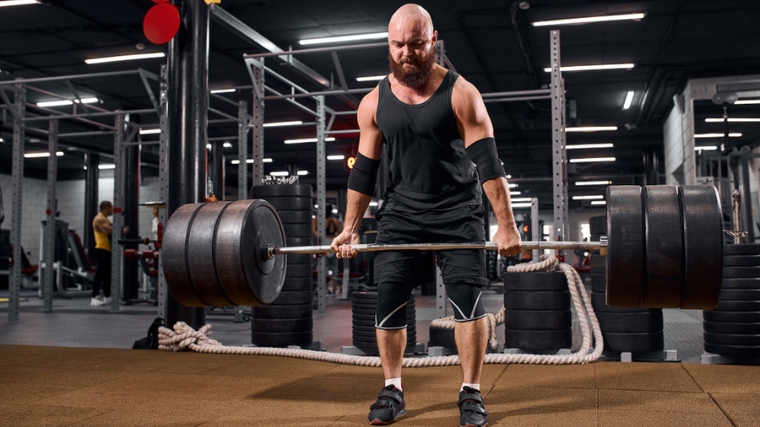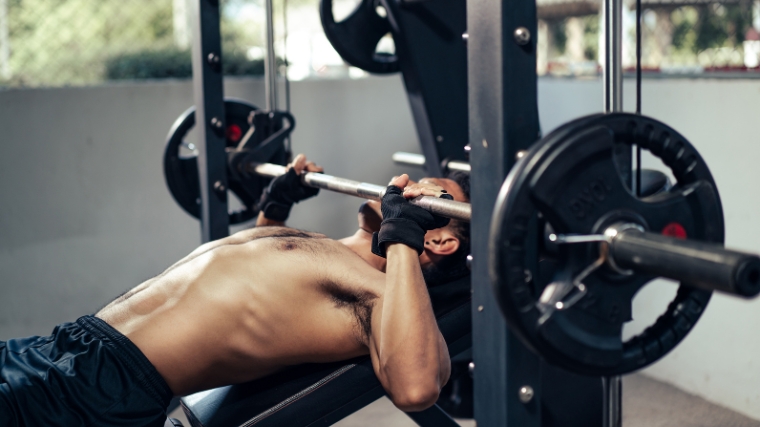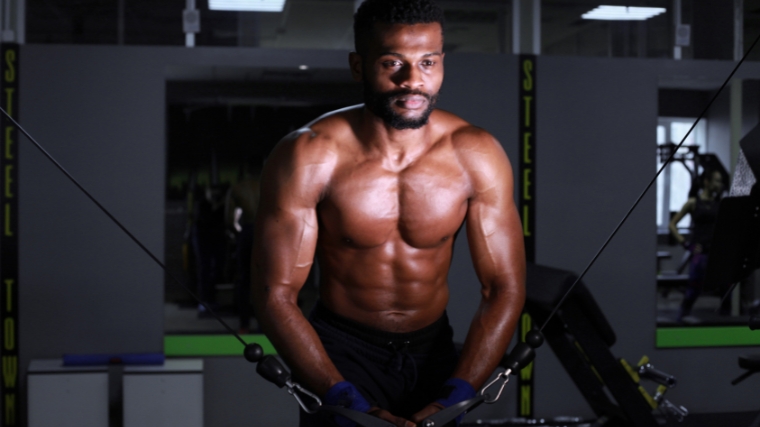Every gymgoer chooses to walk a certain path when they first set foot in the weight room. Your “why” — that is, what got you into exercise as a health habit in the first place — dictates what you want out of lifting. Are you an aspiring bodybuilder who wants biceps peaks that rival Arnold Schwarzenegger’s?
Perhaps you’d rather prioritize your performance. Powerlifting is the pursuit of strength above all else, and few things are as satisfying as setting a new personal record in the gym. To determine your path, you need to understand the nature of both sports.

Knowing the differences — and similarities — between powerlifting and bodybuilding can help you decide which sport is right for you. Here’s what you need to know, and how to begin your own journey.
Defining Powerlifting
Powerlifting is a hobby to some and a career to others, just like any other sport. Athletes who compete in powerlifting are judged on their maximum strength in three exercises:
Every training, nutrition, or recovery-related choice made by the powerlifter is in service of furthering their performance in those three exercises in competition. Among recreational gymgoers, powerlifting is also a popular hobby as a means of developing general bodily strength.
Defining Bodybuilding
By contrast, bodybuilders prioritize form above function — the bodybuilder hits the gym solely to improve the appearance of his or her physique. As a professional sport, bodybuilding offers a wide variety of divisions for men and women:
- Open Bodybuilding
- Classic Physique
- Men’s Physique
- Wheelchair Bodybuilding
- Bikini
- Figure
- Fitness
- Wellness
- Physique
- Women’s Bodybuilding
Each division has its own criteria for success and metrics by which judges evaluate the competitors. Some bodybuilders value overall muscularity more than others, while competitors in the women’s Fitness division must also perform feats of acrobatics and general athleticism on stage.
Powerlifting Vs. Bodybuilding | Training
The distinction between powerlifting and bodybuilding training can be distilled down to a single sentence: Powerlifters train movements, while bodybuilders train muscles. There’s obviously some overlap there, but understanding how those two ideas differ is step one to understanding the sports themselves.
Program Styles
For powerlifting athletes, the squat, bench press, and deadlift dictate the design and functionality of their training programs. Powerlifters rely heavily on the concept of periodization to guide their workouts; staggering the difficulty of their workouts to perform at a high level at very specific moments. (1)

By contrast, bodybuilders are less concerned with the exercises they perform and care far more about generating as much muscular hypertrophy as possible. To do so, bodybuilders will cluster their workouts by muscle group; training their backs on one day, their legs on another, and so on.
Although bodybuilders and powerlifters use different principles to guide their workouts, it’s worth mentioning that there’s a strong synergistic relationship between muscular cross-sectional area, or size, and strength. (2) In real-world terms, this means that powerlifters regularly perform accessory exercises to grow muscles while bodybuilders habitually lift quite heavy, especially on free-weight compound movements.
Frequency
To excel at any sport, you have to practice on a regular basis. This is as true for performance-oriented powerlifters as it is for physique-focused bodybuilders. Athletes in both sports tend to hit the gym between three and seven times a week and, in some cases, more often.
Powerlifting programs are designed to facilitate as much meaningful practice as possible. This means performing the squat, bench, or deadlift (and their variations) often to accumulate training volume and technical practice. Many powerlifters will perform some combination of two of their three competition movements during the same workout and will increase their frequency of practice as they approach a big competition.
On the other hand, bodybuilders often take a more intuitive approach to training frequency. Provided they’ve recovered adequately from prior training, bodybuilders will strive to stimulate their major muscle groups between two and three times per week for optimal growth. (3)
Exercises & Equipment
Powerlifting is a barbell-centric sport. The powerlifter lives and dies by their performance on the powerlifting platform; the back squat, bench press, and deadlift are all performed with a barbell. That said, powerlifters often introduce variety to their workouts via accessory training. Powerlifting accessory exercises include dumbbell movements, resistance band exercises, and the occasional usage of exercise machines as well.

Bodybuilders have no compunction about what tools they use to grow muscle. In fact, bodybuilding exercise selection tends to be determined by whatever movement or implement allows the lifter to best connect, on a mental level, with the muscle they’re trying to grow.
You’ll often see bodybuilding programs packed to the brim with machine and cable exercises, which require less joint stability and allow the bodybuilder to limit themselves only by taking the muscle in question to the brink.
Powerlifting Vs. Bodybuilding | Nutrition
Good nutritional habits are integral to your performance. This is as true for the physique-minded bodybuilder as it is for the powerlifter who obsesses over their proficiency with the barbell. However, nutrition is just as contextual as any other aspect of human performance. Powerlifters and bodybuilders don’t always come to the dinner table with the same goals in mind.
Powerlifting Nutrition Goals
Training for strength means ensuring that you’re recovering from demanding workouts. From a nutritional perspective, this means eating enough calories to fuel heavy strength-focused workouts. However, precise calorie counting isn’t a make-or-break factor for most powerlifters.
That said, nutritional quantity matters just as much as quality for competitive powerlifters who must adhere to a specific weight class. Strength athletes will commonly enter dieting phases in an attempt to cut down to a specific body weight for a powerlifting meet. This nutritional restriction limits the ability to put on muscle, but powerlifters can continue to gain strength even when dieting down. (4)
Bodybuilding Nutrition Goals
Nutrition and training are extremely tightly interwoven for bodybuilders. Physique athletes are highly concerned with their caloric intake, nutrient timing, and maintaining a robust assortment of supplements as well.

Bodybuilders tend to divide their nutritional behaviors into two categories; bulking and cutting. These phases, centered around growing muscle with a caloric surplus and shedding fat with a caloric deficit, respectively, tend to coincide with their competition schedules as well.
During a “contest prep”, a bodybuilder will enter a several-month period of severe nutritional restriction and diet down to very low levels of body fat. This involves consuming few calories and carbohydrates while keeping protein intake high and relying on supplements to shore up nutritional weaknesses. (5)
During the off-season, bodybuilders bulk up with a caloric surplus, going hard and heavy in the kitchen with a hearty caloric surplus and plenty of carbohydrates. Supplements also play an important role, particularly creatine monohydrate, caffeine, and protein powders. (6)
Powerlifting Vs. Bodybuilding | Competition
The structure and criteria of powerlifting and bodybuilding competitions is, perhaps, where the two sports diverge most strongly. Powerlifting competitions are quantitative and metric-driven; bodybuilding shows are subjective and artful.
Powerlifting Competitions
Powerlifters train for weeks and months at a time to display their strength on a single day. Meets, as they’re commonly called, often run from sunrise to sunset — international competitions such as the IPF World Powerlifting Championships occur over the course of several days to a full week or longer.
At a powerlifting meet, athletes in each weight category compete across the back squat, bench press, and deadlift. Each lifter has three opportunities per discipline to lift the heaviest weight possible. Their best results from each movement are then added together to give them a Total, which determines their overall ranking (separate medals are awarded on a lift-by-lift basis as well).
Bodybuilding Competitions
There may be more pageantry at a bodybuilding show than you’d find at a powerlifting meet, but that doesn’t mean that physique athletes don’t go through rigorous preparation for what they call show day.
Bodybuilding shows are multi-day events during which competitors go through several rounds of judging. Competitors are judged on their muscularity, leanness, posing, and other factors by a panel of judges, both individually and in comparison to one another.
Backstage preparation for a bodybuilding show is ritualistic and regimented. Behind the curtains, you’ll see bodybuilders applying layers of tanning oil and running through light circuit training regimens to pump up, all in service of showing off every muscle striation they’ve got.
Can You Do Both Powerlifting and Bodybuilding?
Powerlifting and bodybuilding both have their own unique perks. There’s no shame in wanting to build an impressive physique, add muscle to your frame, or shed some fat. Strength tends to create its own level of comfort and confidence as well. So, you may be wondering, can you do both powerlifting and bodybuilding?
The short answer is yes; but there are caveats. Here’s what you need to know if you want to dabble in both sports:
- Training for strength and hypertrophy have enough overlap that, most of the time, you can accomplish both during a single session.
- Muscle hypertrophy is a physiological process that involves damaging, and then rebuilding, muscle tissue.
- Gaining strength is a neural adaptation; your central nervous system becomes more efficient at generating force in specific contexts.
- The higher you want to climb in either sport, the more concessions you’ll have to make. You can’t do a powerlifting meet while you’re cutting for a bodybuilding show, for example.
Powerbuilding is the colloquial term for mixing powerlifting and bodybuilding training styles together. It’s almost a best-of-both-worlds situation; you can gain strength and muscle simultaneously, though not at the same individual rates had you directed all of your efforts toward one sport.
Sample Powerbuilding Workout
The idea behind powerbuilding is simple: Perform the squat, bench press, deadlift, or one of their variations to kick off your workout. Go hard and heavy and stay in the three-to-six-rep range.
[Read More: Best Upper Chest Exercises and Muscle=Building Workouts]
Afterward, select a couple of different exercises that are better suited to inducing muscular fatigue and hammer them until you’ve got a good pump going. Here’s an example of how a powerbuilding chest workout might look:
- Barbell Bench Press: 5 x 5
- Incline Dumbbell Bench Press: 3 x 8-12
- Cable Flye or Pec Deck Machine: 2 x 12-15
- Skull Crusher or Triceps Pressdown: 2 x 12-15
This training style allows you to adopt progressive overload for the bench press, since you perform it right at the beginning of your workout while you’re full of energy. Afterward, you move on to a variety of different equipment and exercises to fatigue the associated muscle groups, including your upper chest, deltoids, and triceps.
Choose Your Path
Powerlifting and bodybuilding both have their perks. Know, though, that any path is better than none. Whether you’re diving headfirst into physique development or want to build a career in strength, both sports have a lot to offer beyond big biceps and heavy barbells.
References
- Williams, T. D., Tolusso, D. V., Fedewa, M. V., & Esco, M. R. (2017). Comparison of Periodized and Non-Periodized Resistance Training on Maximal Strength: A Meta-Analysis. Sports medicine (Auckland, N.Z.), 47(10), 2083–2100.
- Akagi, R., Kanehisa, H., Kawakami, Y., & Fukunaga, T. (2008). Establishing a new index of muscle cross-sectional area and its relationship with isometric muscle strength. Journal of strength and conditioning research, 22(1), 82–87.
- Schoenfeld, B. J., Ogborn, D., & Krieger, J. W. (2016). Effects of Resistance Training Frequency on Measures of Muscle Hypertrophy: A Systematic Review and Meta-Analysis. Sports medicine (Auckland, N.Z.), 46(11), 1689–1697.
- Murphy, C., & Koehler, K. (2022). Energy deficiency impairs resistance training gains in lean mass but not strength: A meta-analysis and meta-regression. Scandinavian journal of medicine & science in sports, 32(1), 125–137.
- Helms, E. R., Aragon, A. A., & Fitschen, P. J. (2014). Evidence-based recommendations for natural bodybuilding contest preparation: nutrition and supplementation. Journal of the International Society of Sports Nutrition, 11, 20.
- Iraki, J., Fitschen, P., Espinar, S., & Helms, E. (2019). Nutrition Recommendations for Bodybuilders in the Off-Season: A Narrative Review. Sports (Basel, Switzerland), 7(7), 154.
Featured Image: UfaBizPhoto / Shutterstock